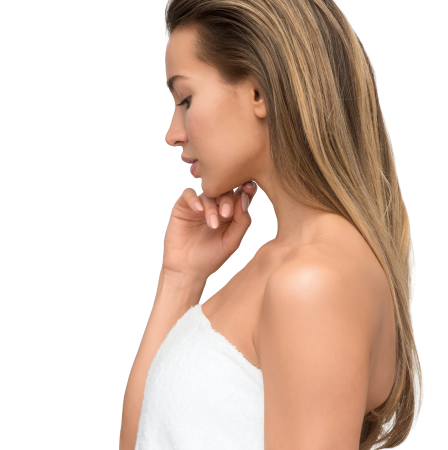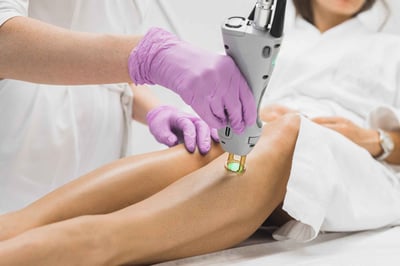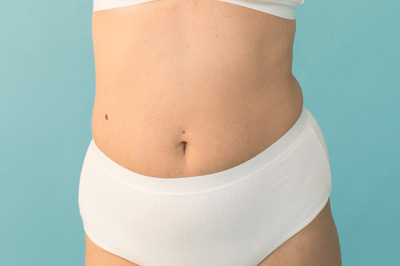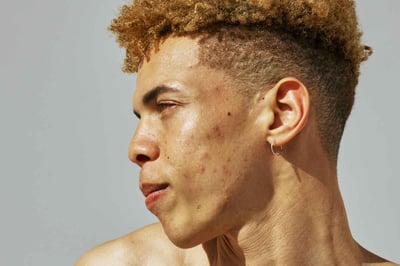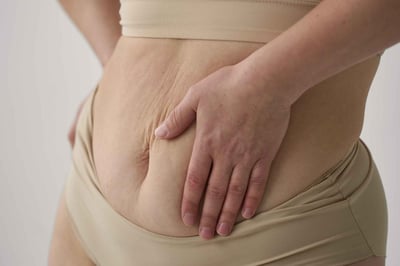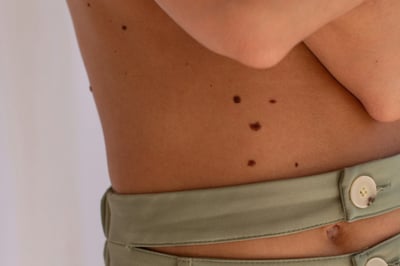Age Spots
Age spots are small, flat brown, grey, or black blemishes on the skin. They vary in size and mostly appear in areas frequently exposed to sun, such as the face, hands, shoulders, and arms. Other names for age spots are sun spots, liver spots, senile lentigo, or solar lentigines.
Skin gets its color from melanin (a naturally occurring substance), made by skin cells. When skin cells are damaged, they produce excessive melanin. As a result, melanin clusters under the skin, causing the skin to appear darker. Age spots are not painful but can cause self-consciousness and embarrassment, influencing social interactions and overall quality of life.
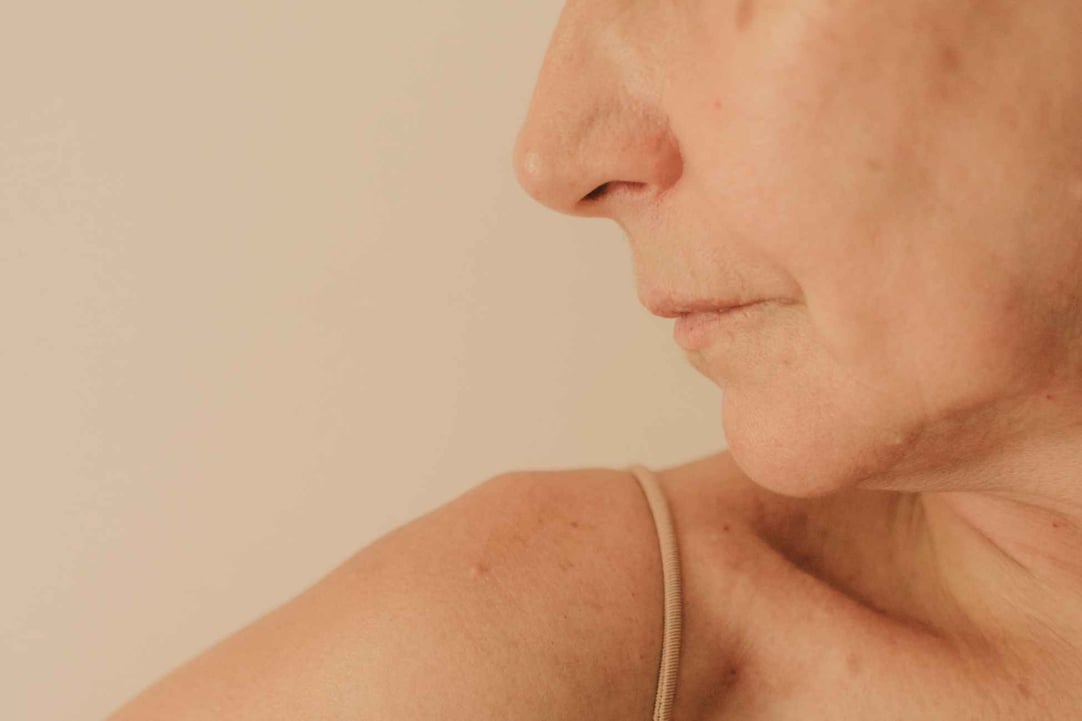
What is Age Spots
As discussed earlier, age spots are flat, oval-shaped black, grey or brown areas of increased pigmentation that often appear on the hands, face, and other skin areas exposed to the sun.
Difference
Age spots differ from moles, freckles, and melanoma in several ways:
Melanoma
Melanoma is a type of skin cancer that develops when the melanin-producing cells in the skin, called melanocytes, grow uncontrollably. Unlike freckles, moles, and sun spots, melanoma can be life-threatening if not detected and treated early. It may appear as an irregularly shaped, dark-colored spot or patch on the skin.
Freckles
Freckles are small, flat, and light brown or reddish-brown spots on the skin caused by increased melanin production. They are more common in fair-skinned people and tend to appear on areas of the skin that are frequently exposed to the sun, such as the face, arms, and shoulders.
Moles
Moles are also caused by an overproduction of melanin, but they are typically darker and larger than freckles. Moles are usually brown or black but can also be pink, red, or skin-colored. Most moles are benign, but some may develop into melanoma, especially if they change in size, shape, or color over time.
Common Types of Age Spots
Age spots, also known as liver spots or solar lentigines, are most common in older adults and can appear on the face, hands, arms, and other areas of the skin regularly exposed to the sun. Many different types of spots appear on your skin as you age.
Solar lentigines (sunspots)
Solar lentigines are caused by long-term exposure to the sun's ultraviolet (UV) radiation. They are common in people over the age of 50. While they are usually harmless and do not require treatment, some people may choose to have them removed for cosmetic reasons. Protecting your skin from the sun to prevent the development of solar lentigines is important.
Cherry hemangiomas
Cherry hemangiomas are common benign skin proliferation (rapid cell growth). They are also known as cherry angiomas, adult hemangiomas, or senile angiomas—the term “cherry” refers to their color and appearance on the skin.
Cherry angiomas mostly appear with age after about 30. They are mostly developed in healthy individuals. This age spot type begins as bright red, flat macules and grows into 1 to 5 mm red papules. They are usually asymptomatic but can bleed with trauma. Angiomas commonly appear after 30 years of age and can be treated if you don’t like their appearance.
Seborrheic keratoses
Seborrheic keratoses are common benign skin growths that typically develop in middle-aged or older adults. They can appear as single or multiple growths and vary in color from light tan to black. They often have a waxy or scaly appearance and can be slightly raised from the skin's surface.
While seborrheic keratoses are generally harmless and don't require treatment, some people may choose to have them removed for cosmetic reasons.
What Causes Age Spots
Age spots are strongly related to chronic sun exposure and are associated with photodamage. The accumulation of excess melanin in response to chronic sun exposure causes them. Melanin pigment gives our skin its color. Other possible causes are skin trauma, age, and hormonal changes.
UV radiation exposure
Ultraviolet (UV) light exposure from the sun or tanning beds can speed up melanin production. This pigment gives our skin color and causes age spots or solar lentigines to develop. UV radiation can also damage the skin's DNA, leading to mutations that can cause skin cancer.
Age
While age spots can develop at any age, they are more commonly seen in people over 50, which is why they are often associated with aging. It is because the skin's natural defense mechanisms against UV radiation, such as melanin production, may become less effective as we age, making us more susceptible to the harmful effects of UV radiation.
Genetics
While there is no evidence to suggest that age spots have a significant genetic component, certain genetic conditions, such as xeroderma pigmentosum, can increase a person's risk of developing sun damage, age spots, and skin cancer.
Tanning beds use
Tanning beds are devices that emit ultraviolet (UV) radiation to darken the skin artificially. Prolonged use of tanning beds can lead to increased melanin production, which can cause age spots and other forms of sun damage. Limiting or avoiding tanning bed use is important to reduce the risk of skin damage and skin cancer.
Procedures That Remedy Age Spots
Years of suntanning or exposure to sunlight for an extended period may lead to age spots. Age spots are generally harmless; many people find them unappealing and seek to reduce their appearance. You can practice a few remedies or undergo certain treatments to protect your skin and make it feel and appear better.
Laser therapy
Laser therapy uses light beams of different wavelengths to treat age spots. The wavelength of laser light depends on the specific condition being treated. One or two treatment sessions can treat age spots effectively and give results better than topical creams and ointments. However, it is not the best choice for everyone. Consulting your healthcare provider before undergoing the treatment is important.
- Find doctors who offer Chemical Peel
Chemical peels can effectively improve the appearance of age spots by removing the top layer of skin with the help of a chemical solution and replacing it with new skin. Chemical peels are available in different strengths, from mild to deep. The peel strength will depend on the severity of the age spots and other skin concerns.
Cryotherapy
Cryotherapy (freezing) treats age spots by applying liquid nitrogen on pigmented or sun-damaged skin for five seconds or less with the help of a cotton swab. The liquid nitrogen freezes the top layer of the skin, causing the age spot to blister and eventually slough off as the skin heals.
Frequently Asked Questions
Are age spots dangerous?
Age spots are typically harmless and do not pose health risks. However, in rare cases, if they change their size, color, or shape, they may signify serious health concerns, such as the risk of melanoma (a serious type of skin cancer). It's important to monitor your age spots constantly and immediately report to your healthcare provider if you observe changes in their appearance or if they itch, ache, or bleed. The risk of health concerns can be minimized significantly by protecting your skin from photodamage and UV radiation.
Can age spots be prevented?
Age spots cannot be completely prevented. However, there are certain ways to significantly minimize the risk of developing them. Things you can do to prevent age sports are:
Protect your skin from the sun
Avoid tanning beds
Be mindful of your skin changes
Use topical creams and sunscreens
Keep your skin healthy
Protecting your skin can help reduce your risk of developing age spots and maintain healthy, beautiful skin.
Do age spots go away on their own?
Age spots do not go away on their own. Rather, as we age, they become more prominent over time due to prolonged sun exposure.
Several treatment options are available for treating age spots, including laser therapy, cryotherapy, chemical peels, and topical creams containing ingredients such as hydroquinone or retinoids. These treatments can help fade the appearance of age spots and may even remove them completely.
How long does it take to see results from age spot treatments?
The time taken for age spot treatment to show visible results depends on the chosen technique, individual skin type, and the patient's health history.
Here are some estimated timelines for various age spot treatments:
Laser therapy: Results may be visible after the first treatment, but it can take several treatments over several weeks to see significant improvement.
Cryotherapy: The treated age spots may take a few weeks to peel off. Improvement in the appearance of age spots may be visible in a few weeks to a few months.
Chemical peels: Mild chemical peels may imp... Show more.

